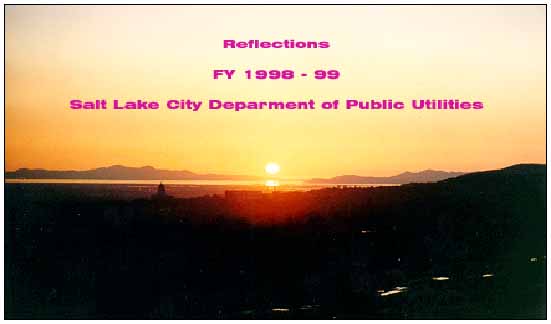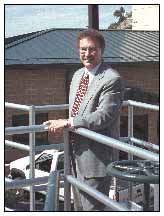
October 20, 1999
______________________________________________________________
Director's Report
LeRoy W. Hooton, Jr. Director |
In 1928, Mayor John Bowman proclaimed that "A City can
never be greater than its water supply," and then put in motion an action plan to develop a water supply for 500,000 people. Today nothing is more important than protecting the quality of
that water supply. This year was a milestone in developing programs to protect the water supply developed by Mayor Bowman and those leaders who followed him. With the passage by the City Council of the '99 Watershed
Management Plan and Ground Water Source Protection Ordinance, the City's water supply will be protected from pollution for generations to come. Equally noteworthy is the extraordinary performance of the drinking water and
wastewater treatment facilities. The City's three drinking water plants continue to produce water that far exceeds federal drinking water standards. They completed the third phase of
the EPA Partnership for Safe Water Program and received the program's "Directors Award." The Water Reclamation Plant joined a handful of other plants
nationally to receive the Association of Metropolitan Sewage Agency's "Platinum Award" for 5 years of perfect NPDES permit compliance. Extraordinary performance indeed! All of
those involved are to be commended in the highest of terms for these extremely important accomplishments. '99 Watershed Management Plan
The '99 Watershed Management Plan updated the 1988 Plan and reflected the enormously increased use of the canyons over the past decade. Traffic counts in Big and Little
Cottonwood Canyons indicate a 30 percent increase over the past 10 years. In 1996 nearly 1.6 million vehicles traveled Big Cottonwood Canyon. Canyon watchers all agree that the
numbers of users are increasing at a rapid rate. Representatives from the U.S. Forest Service, County Sheriff's and City and County Health Department agreed with Public Utilities'
Canyon Patrol Officers that more and more people are using the canyons for recreation. It's difficult to determine the exact numbers, but the increase is obvious to those who have
jurisdiction in the canyon watersheds. The biggest change is the number of people using the back county. Despite the increase, watershed management programs have been effective in
controlling the pollution levels in the various canyon streams. However, there have been noticeable increases in coliform bacteria levels.
One of the major outputs from the '99 Management Plan is the requirement to develop sound scientific data on which to make critical future decisions. Recreationist, environmentalist and
the ski industry all agreed that there was not enough data to support taking any strong action one way or the other in managing the canyon watersheds. A panel of national experts will be
assembled to help determine what data is needed to measure pollution indicators in the watershed and canyons streams. It's acknowledged that there are not scientific water quality
studies on high elevation canyon streams with fast moving cold waters. The goal is to have extensive studies, evaluation of data and conclusions made by the panel of experts. Involving
academia in the studies will be through partnerships with state colleges and universities. Other major recommendations of the plan include public education, forming partnerships and acquiring additional watershed property. Ground Water Protection Just as important is ground water supply protection. During 1998, Salt Lake City and other county water entities joined together to develop a valley-wide ground water protection
ordinance. About 40 percent of the valley's drinking water supply of 130,000 acre-feet of water come from over 150 wells. Salt Lake City relies on ground water for about 20 percent
of its water supply and it is critical for summer peaking flows within the water distribution system. The need to protect the ground water became apparent in 1991 when the City's Sugar House
Well became polluted with PCE, a common dry cleaning solvent. This was reinforced again in 1995 when the 6200 South Well was similarly contaminated. The source of the
contamination to both wells has not been found. In an effort to coordinate a valley-wide protection zone and to cross over jurisdictional
boundaries, all of the water entities in the valley joined together to conduct a ground water study and develop a model ordinance. Some wells that belong to Salt Lake City are outside
its corporate limits, and likewise some other entities' wells have protection zones that extend into Salt Lake City. Therefore, the model ordinance was developed with input from all of the
county's water entities. The final model ordinance provided a level of protection that all water entities were willing to accept for their own wells and for the wells and protection zones of
other entities' wells within their boarders. Primary recharge areas are now protected under the ordinance. Hopefully, this effort will prevent further ground water pollution.
There has also been progress in protecting water quality in Deer Creek Reservoir. Working with the Provo River Water Users Association, grazing has been eliminated around the
reservoir. Furthermore, new water quality regulations have been implemented in the recreation areas through a "Resource Management Plan" with the U.S. Bureau of Reclamation.
As the Wasatch Front continues to grow, water supply and water quality becomes increasingly more important. Protecting the sources of supply from pollution will insure that
future generations will enjoy the benefits of safe drinking water. To this end, the achievements of this past year have been enormous.
